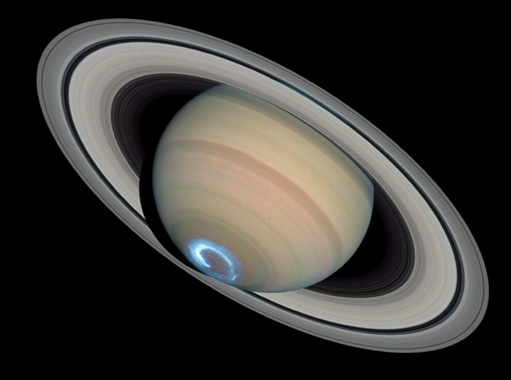Saturn Aurora

The ultraviolet image of the southern polar region of Saturn with its aurora was taken on January 28, 2004 by the Hubble Space Telescope's Imaging Spectrograph. The visible part of the image was taken by Erich Karkoschka of the University of Arizona using the telescope's Advanced Camera for Surveys on March 22, 2004. The ultraviolet image was transferred to the visible blue to show the geometry of the auroral display and superimposed upon the subsequently obtained visible image, as I understand it. Photo credit: NASA, ESA, J. Clarke (Boston University), and Z. Levay (STScI).

The ultraviolet parts of these three superimposed images were taken on January 24,26, and 28, 2004. This shows the dynamic nature of the auroral display. On Earth, auroral storms may develop in about 10 minutes last for a few hours, whereas Saturn's auroral displays always appear bright and may last for several days (NASA).
"The observations, made by Hubble and the Cassini spacecraft, while enroute to the planet, suggest that Saturn's auroral storms are driven mainly by the pressure of the solar wind -- a stream of charged particles from the Sun -- rather than by the Sun's magnetic field. The aurora's strong brightening on Jan. 28, 2004 corresponds with the recent arrival of a large disturbance in the solar wind. The image shows that when Saturn's auroras become brighter (and thus more powerful), the ring of light encircling the pole shrinks in diameter."(NASA)

|
While the blue representation of the auroral display is dramatic and appropriate, transferring the ultraviolet data to the nearest visible color, it is a little misleading in that it does not represent what the human eye would see from a nearby spacecraft. If the ultraviolet is excited, then one can be fairly confident that the visible spectra would also be excited. It would then be expected that the hydrogen of the atmosphere would give off the bright n=3->2 red emission known astronomically as the H-alpha line. The above is a NASA artist's conception of the visual phenomenon as observed by the human eye. The credit for this graphic is NASA, ESA and A. Schaller, STScI-PRC05-06b. The familiar visible hydrogen spectrum is shown at right. |

|
| Saturn Concepts |
Solar System Illustration
Solar System Concepts
| HyperPhysics********** Astrophysics | R Nave |